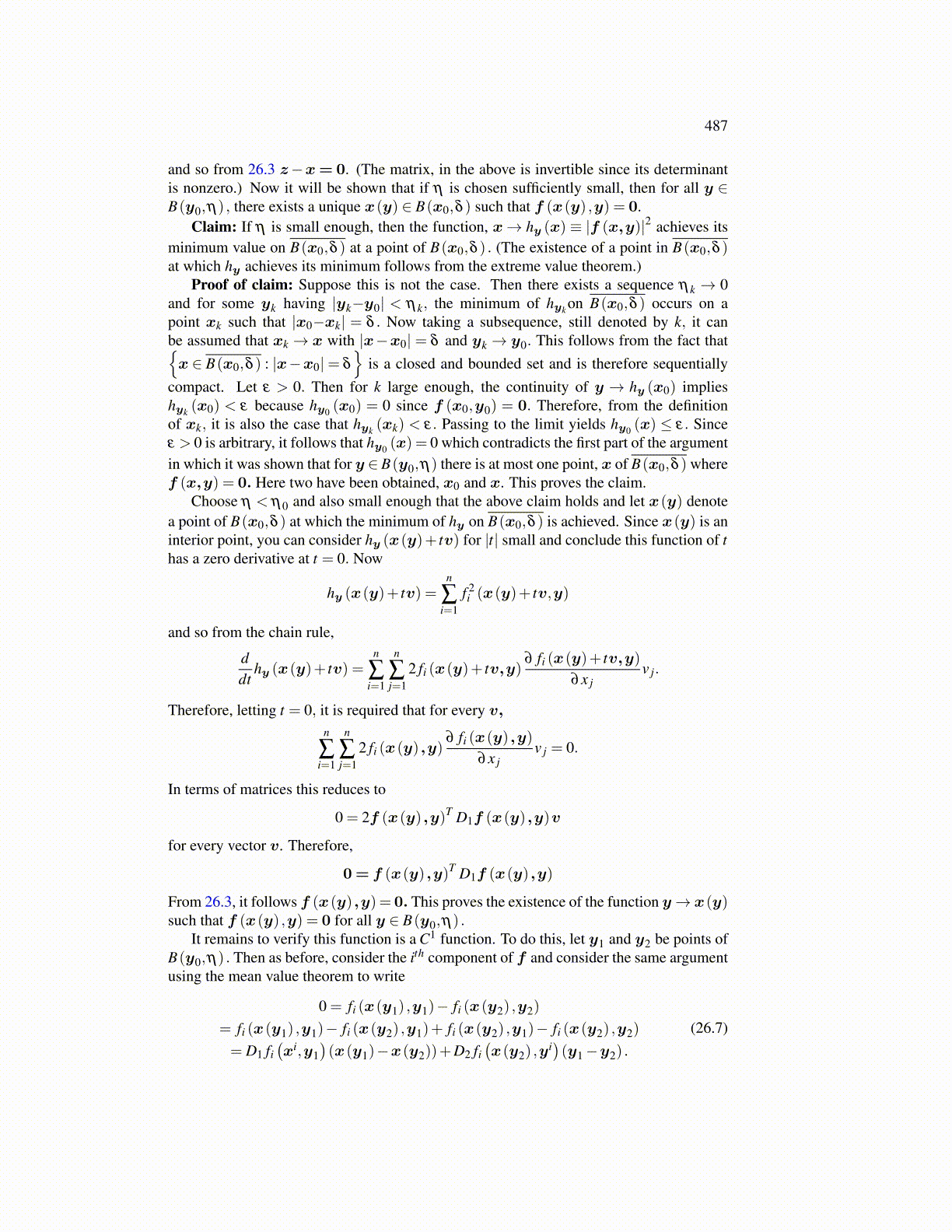
487
and so from 26.3 z−x= 0. (The matrix, in the above is invertible since its determinantis nonzero.) Now it will be shown that if η is chosen sufficiently small, then for all y ∈B(y0,η) , there exists a unique x(y) ∈ B(x0,δ ) such that f (x(y) ,y) = 0.
Claim: If η is small enough, then the function, x→ hy (x) ≡ |f (x,y)|2 achieves itsminimum value on B(x0,δ ) at a point of B(x0,δ ) . (The existence of a point in B(x0,δ )at which hy achieves its minimum follows from the extreme value theorem.)
Proof of claim: Suppose this is not the case. Then there exists a sequence ηk → 0and for some yk having |yk−y0| < ηk, the minimum of hyk on B(x0,δ ) occurs on apoint xk such that |x0−xk| = δ . Now taking a subsequence, still denoted by k, it canbe assumed that xk → x with |x−x0| = δ and yk → y0. This follows from the fact that{x ∈ B(x0,δ ) : |x−x0|= δ
}is a closed and bounded set and is therefore sequentially
compact. Let ε > 0. Then for k large enough, the continuity of y → hy (x0) implieshyk (x0) < ε because hy0 (x0) = 0 since f (x0,y0) = 0. Therefore, from the definitionof xk, it is also the case that hyk (xk) < ε. Passing to the limit yields hy0 (x) ≤ ε. Sinceε > 0 is arbitrary, it follows that hy0 (x) = 0 which contradicts the first part of the argumentin which it was shown that for y ∈ B(y0,η) there is at most one point, x of B(x0,δ ) wheref (x,y) = 0. Here two have been obtained, x0 and x. This proves the claim.
Choose η < η0 and also small enough that the above claim holds and let x(y) denotea point of B(x0,δ ) at which the minimum of hy on B(x0,δ ) is achieved. Since x(y) is aninterior point, you can consider hy (x(y)+ tv) for |t| small and conclude this function of thas a zero derivative at t = 0. Now
hy (x(y)+ tv) =n
∑i=1
f 2i (x(y)+ tv,y)
and so from the chain rule,
ddt
hy (x(y)+ tv) =n
∑i=1
n
∑j=1
2 fi (x(y)+ tv,y)∂ fi (x(y)+ tv,y)
∂x jv j.
Therefore, letting t = 0, it is required that for every v,
n
∑i=1
n
∑j=1
2 fi (x(y) ,y)∂ fi (x(y) ,y)
∂x jv j = 0.
In terms of matrices this reduces to
0 = 2f (x(y) ,y)T D1f (x(y) ,y)v
for every vector v. Therefore,
0 = f (x(y) ,y)T D1f (x(y) ,y)
From 26.3, it follows f (x(y) ,y) = 0. This proves the existence of the function y→ x(y)such that f (x(y) ,y) = 0 for all y ∈ B(y0,η) .
It remains to verify this function is a C1 function. To do this, let y1 and y2 be points ofB(y0,η) . Then as before, consider the ith component of f and consider the same argumentusing the mean value theorem to write
0 = fi (x(y1) ,y1)− fi (x(y2) ,y2)
= fi (x(y1) ,y1)− fi (x(y2) ,y1)+ fi (x(y2) ,y1)− fi (x(y2) ,y2)
= D1 fi(xi,y1
)(x(y1)−x(y2))+D2 fi
(x(y2) ,y
i)(y1−y2) .
(26.7)